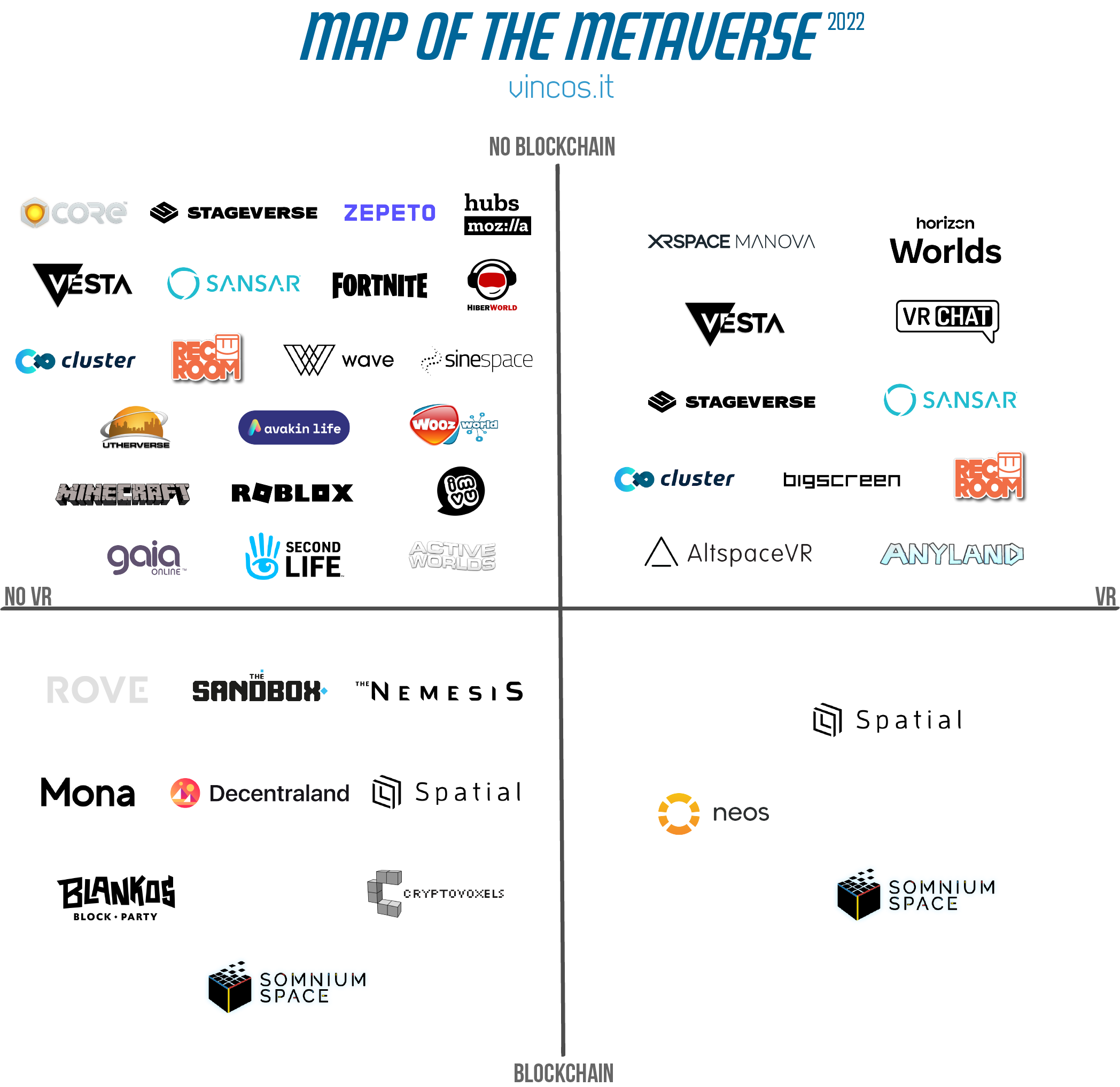Everyone seems to know what (the hell) the metaverse is. Some say it is basically virtual reality; others argue it’s “augmented” reality; others describe it as nothing else than 3D video games, now labelled with a new shiny name.
What is not here is the metaverse meant as the next evolution of the Internet. A web made of 3D worlds, persistent and interoperable, not just bidimensional pages (see Matthew Ball essay). Utopia? Maybe. In the meantime we must settle for a multitude of independent virtual worlds that I have decided to map. Why? Because I couldn’t find anything as such, and to offer everyone a platform to start from, in order to (at least) imagine in what directions they might evolve.
I have considered the digital universes with the following characteristics:
- 3D
- Shared (worlds with multiple people)
- Social (no pure videogames, typically lacking the main social features)
- Identity: avatars can move freely in space; people can use them to interact with the virtual environment
I have ruled out business platforms (i.e. Engage and Virbela) and creation platforms (made to build 3d worlds (i.e.Vircadia and OpenSimulator).
My Map of the Metaverse shows virtual worlds segmented by access mode (virtual reality devices or desktop/web browsers) and the technology powering their internal economy (blockchain or not). Each quadrant shows logos by release date (from older to recent, from bottom to top).
Virtual Reality Metaverses (no blockchain)
In the first quadrant you can find the 3D worlds that you can explore with a virtual headset. They don’t use blockchain technology to power their internal economy.
What is the state of these VR apps? We know that Oculus, the market leader, sold 10 million devices. In terms of adoption, it seems that VR Chat totals 4 million users. Rec Room and AltSpace VR (Microsoft) gather 1 million users. Horizon Worlds counts 300.000 users.
- Manova World (2022)
- Horizon Worlds (2021)
- Vesta (2018)
- VR Chat (2017)
- Stageverse (2017)
- Sansar (2017)
- Cluster (2017)
- Bigscreen VR (2016)
- Rec Room (2016)
- AltspaceVR (2013)
- Anyland (2012)
Desktop/Browser-based Metaverses (no blockchain)
In the second quadrant we can find those virtual worlds you can enter via browser or by downloading a desktop app. It is the largest group as it includes older solutions like Active Worlds, Second Life and Habbo.There are also games with social features (like Fortnite, Roblox) and worlds targeted for kids (like Gaia Online, Woozworld, Avakin Life, Minecraft).
In terms of usership, Roblox is the largest world (54,7 million daily active users). Fortnite is estimated to have around 24 million daily active users, while Minecraf is around 15 million DAU.
- Core (2021)
- Stageverse (2021)
- Zepeto (2018)
- Mozilla hubs (2018)
- Vesta (2018)
- Sansar (2017)
- Fortnite (2017)
- Hiberworld (2017)
- Cluster (2017)
- Rec Room (2016)
- Wave (2016)
- Sinespace (2016)
- Utherverse (2014)
- Avakin Life (2013)
- Woozworld (2010)
- Minecraft (2009)
- Roblox (2006)
- IMVU (2004)
- Gaia Online (2004)
- Second Life (2003)
- Active Worlds (1995)
Desktop/Browser-based Metaverses (on blockchain)
The third quadrant is about desktop/browser-based metaverses that use blockchain. WIthin these worlds you can buy virtual lands and tokenized objects, using the native crypto currency. There is a limited number of projects, although awareness is growing massively, especially from brands. There are no reliable data on users, except for Decentraland, counting approximately 300.000 monthly users (my estimation).
- Rove (2022)
- The Sandbox (2021)
- The Nemesis (2021)
- Mona (2021)
- Decentraland (2020)
- Spatial (2020)
- Blankos (2020)
- Cryptovoxels (2018)
- Somniumn Space (2017)
Virtual Reality Metaverses (on blockchain)
In the fourth quadrant there are only three projects developed on blockchain for virtual reality headsets.
- Spatial (2020)
- Neos (2018)
- Somniumn Space (2017)
If you want to help me to improve my map, please email me.
Metaverse Users
| Metaverse | Registered Users | Monthly Active Users | Daily Active Users | Source |
|---|---|---|---|---|
| Roblox | n.a. | 210.000.000* | 54.700.000 | Roblox |
| Minecraft | n.a. | 170.000.000* | 15.000.000* | |
| Fortnite | n.a. | 270.000.000* | 24.000.000* | |
| Decentraland | n.a. | 300.000 | 18.000 | Wagner James Au |
| The Sandbox | 2.000.000 | n.a. | n.a. | Dean Takahashi |
| Altaspace VR | n.a. | 1.000.000* | n.a. | |
| VR Chat | n.a. | 4.000.000* | – | |
| Horizon Worlds | n.a. | 300.000 | – | The Verge |
| Second Life | – | 1.000.000* | n.a. | |
| Rec Room | 5.000.000* | n.a. | ||
| IMVU | n.a. | 7.000.000* | n.a. | |
| Zepeto | 300.000.000 | 20.000.000 | – | Naver |

